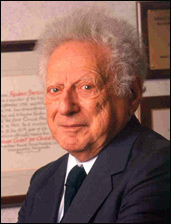Reuben Berman
Year: August 22nd, 2002
Location: St. Louis Park, Minnesota
Interviewed by: Blackburn, Henry
Abstract
Reuben Berman was important to CVD epidemiology as an early collaborator of Ancel Keys and in his effective implementation of Minnesota clinics for numerous preventive trials early in history. The interview roams over this experience, culminating in the organization of the Berman Center, an on-going trial center within the Metropolitan Medical Center of Minneapolis.
Berman describes how he met and started collaboration with Ancel Keys and the University. He talks about his connections with central figures in cardiology in the community: Ernst Simonson, Leo Rigler, Paul White, Jessie Marmoston, George Fahr, and Walt Lillehei. He briefly describes his key roles in the Coronary Drug Project and the Hypertension Detection and Follow-up Program, and discusses early clinical advances in medicine and cardiology in Minnesota. (Henry Blackburn)
Quotes
One great leap, was the ability to put a tube into an artery and get samples of blood or go wherever you wanted to go.
The greatest leaps, I have to admit, were surgical not medical. The surgeons were able to expose any part of the heart and eventually to correct deformity.
RB: I want to tell you something. When you travel with Ancel Keys and Paul White, you are traveling with nobility in the scientific world. I spent a week in Sardinia and roomed with Paul White and he regaled me with stories, which I’m sure you might want to use.
HB: Absolutely.
RB: I’ll go right ahead with one story. The story that he told me was about an incident in London where he picked up the newspaper at the newsstand and it was all about the heart attack of the King of Greece.
HB: Constantine, OK.
RB: Paul said, “I’m sitting there in my room in the hotel reading this thing and thinking, who is the best man in Europe to take care of the King of Greece? Why, it is I.”
HB: “It is I,” he said!
RB: Yes. The next day he was in Greece.
RB: Like Paul White, I picked up a newspaper and the newspaper said that President Johnson is interested in the prevention of heart disease. And Jeremiah Stamler had suggested a really large study of maybe 50,000 people. So I, like Paul White, I picked up the phone and said, “That’s for me.” So I called NIH and I said, “You’re looking for 100 coronary centers…..to study 50,000 people and I can almost supply the patients from my own practice.” The next thing I knew is a fellow from the NIH called me and said, “How do you intend to do this?” . . .And sure enough he said, “You’re in.”
RB: Yes, I tell you I use the analogy of looking over at Vesuvius and deciding what’s going on below. Because Mose Barron had the story in his hand. What’s the story? It was a drunk who had a stone in his common duct and the stone destroyed his pancreas…….
HB: Destroyed the exocrine function. The exocrine function of the pancreas.
RB: Endocrine, too.
HB: Oh, endocrine too. I thought the islets . . .
RB: Yes, that’s right. The islets persisted. You’re absolutely right. And Mose pointed out they persisted.
HB: He had it right in his hands, the cause of diabetes and its cure.
RB: He had it right there, that’s right. And then this guy in Canada, Banting, read that paper. In the original paper he says that reading this paper at 3:00 in the morning, this paper by Barron, B-a-r-r-o-n, it occurred to him that the thing to do is destroy the pancreas and then see what you’ve got. Because when you mash up pancreas the pancreatic enzyme destroys whatever is there. If I can destroy the pancreas without destroying the islets, then I have something. But the idea was in Mose’s head.
Full Transcript Access
Full transcripts of interviews may be made available to those engaged with original materials for scholarly studies by contacting us.
